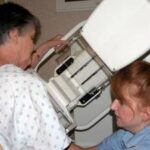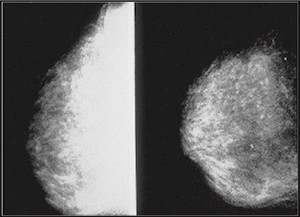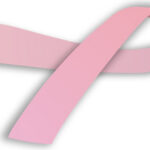Breast calcifications are small buildups of calcium in the breasts. In mammograms, they are identifiable as white spots on the x-ray image. Breast calcifications are usually harmless benign deposits, but depending on their characteristics they can also be indicative of breast cancer and a few other conditions. Per the Mayo Clinic, cancerous growths are generally differentiated from benign breast calcifications by shape, size, and number.
According to the National Institutes of Health, in mammogram imaging two types of breast calcifications may be identified: macrocalcifications and microcalcifications. As their etymology indicates, macrocalcifications are large calcium deposits and microcalcifications are small bits of calcium. Macrocalcifications are usually nothing to worry about; they are typically benign deposits with noncancerous causes.
Like macrocalcifications, most microcalcifications are benign. However, the National Cancer Institute reports that microcalcifications can point to locations of rapid cell division; when clusters of microcalcifications are found together, they can indicate cancerous growths. When these small breast calcifications are found in a mammogram, and particularly clusters of microcalcifications, further testing is generally administered.
When a small number of microcalcifications are found, the next step is often a follow-up mammogram. The National Institutes of Health report that this is done to monitor the progress of these deposits. When large clusters of breast calcifications are found and the doctor suspects that breast cancer may be the cause, a biopsy may be performed to analyze the suspicious tissue.
Medical conditions that are causes of breast calcifications include breast cancer, mastitis (an infection), and mammary duct ectasia, per the Mayo Clinic. According to the National Cancer Institute, there are nearly 200,000 new cases of breast cancer diagnosed each year. The National Health Service of the UK reports that breast cancer is the most common cancer among women in the country with nearly 50,000 new cases each year.
Mastitis is a bacterial infection of the breast and one of the causes of breast calcifications. According to the University of Maryland Medical Center, mastitis often occurs when breast-feeding. Along with causing breast calcifications, symptoms of mastitis may include pain and swelling, nausea and vomiting, and a lump or enlargement of one breast. Mastitis is usually simple to treat with antibiotics.
In another cause of breast calcifications, mammary duct ectasia, a milk duct in the breast becomes obstructed. Mammary duct ectasia can cause a breast lump, discharge from the nipple, and tenderness around the affected area. The condition usually goes away on its own, though the Mayo Clinic reports that in some cases it can cause infection and antibiotics are prescribed.
Breast calcifications are typically more scary than harmful. Most are not associated with any medical condition and many others are caused by a simple infection. In some cases, however, clusters of small breast calcifications can point to breast cancer and further screening is administered. Any questions about the causes of breast calcifications, breast cancer, mastitis, and mammary duct ectasia should be directed to an individual’s health care provider.
References:
Breast calcifications. Mayo Clinic.
Breast cancer. National Cancer Institute.
Breast cancer (female). National Health Service.
Breast infection. University of Maryland Medical Center.
Mammary duct ectasia. Mayo Clinic.
Mammogram – calcifications. National Institutes of Health.



